This article shines a light on how imitation ABA examples can truly enhance learning for children, especially those with autism and other behavioral challenges. These examples are vital for developing key skills like communication, social interaction, and motor abilities. Techniques such as modeling and reinforcement play a significant role here, fostering a nurturing learning environment that can improve therapy outcomes.
Let’s explore this together! By using relatable examples, we can understand the challenges parents face and how these techniques can make a difference. Imagine your child gaining confidence in social situations or expressing themselves more clearly—these are the wonderful outcomes we’re aiming for!
With the right support and resources, you can help your child thrive. We’re here to help you every step of the way, so don’t hesitate to reach out and share your thoughts or experiences!
Imitation is a cornerstone in child development, especially within Applied Behavior Analysis (ABA) therapy. This powerful learning tool not only helps children with autism, ADHD, and learning disabilities but also nurtures essential skills like communication and social interaction. As children engage in imitation, they unlock the potential for greater independence and improved relationships.
But how can parents and caregivers effectively weave imitation strategies into daily routines to maximize these benefits? Let’s explore some practical examples and techniques that reveal the transformative impact of imitation in enhancing learning outcomes for our little ones. Together, we can make a difference!
Rori Care - ABA Therapy emphasizes how crucial imitation ABA examples are in Applied Behavior Analysis (ABA) therapy. This is a key learning tool for children facing autism, ADHD, learning disabilities, and other behavioral challenges. Many children struggle with copying, making it vital to develop these skills for their growth.
By promoting emulation, certified behavior analysts can craft personalized, patient-focused strategies that truly help in learning and encourage positive behaviors. These skills are essential for building strong interpersonal connections and effective communication. Research shows that children who develop solid mimicry skills often pick up language faster and show improved social abilities.
Techniques like modeling, prompting, reinforcement, and both contingent and reciprocal mimicry training play a pivotal role in this process. They allow kids to observe and imitate actions in a supportive environment. Plus, interactive activities that involve mimicry not only enhance learning but also boost a child's ability to connect with their surroundings and peers. This makes imitation ABA examples a cornerstone of successful ABA practices.
As children gain confidence in their mimicking abilities, they become better equipped to navigate social situations and develop essential life skills. This ultimately paves the way for greater independence and success. Parents can play a significant role in this journey by adding simple imitation ABA examples into their daily routines, like playing games that encourage copying actions or sounds.
Additionally, training for caregivers is vital. It empowers them with ABA principles and strategies to actively support their child's behavioral goals while engaging in data collection. Let’s explore this together! We’re here to help you every step of the way!
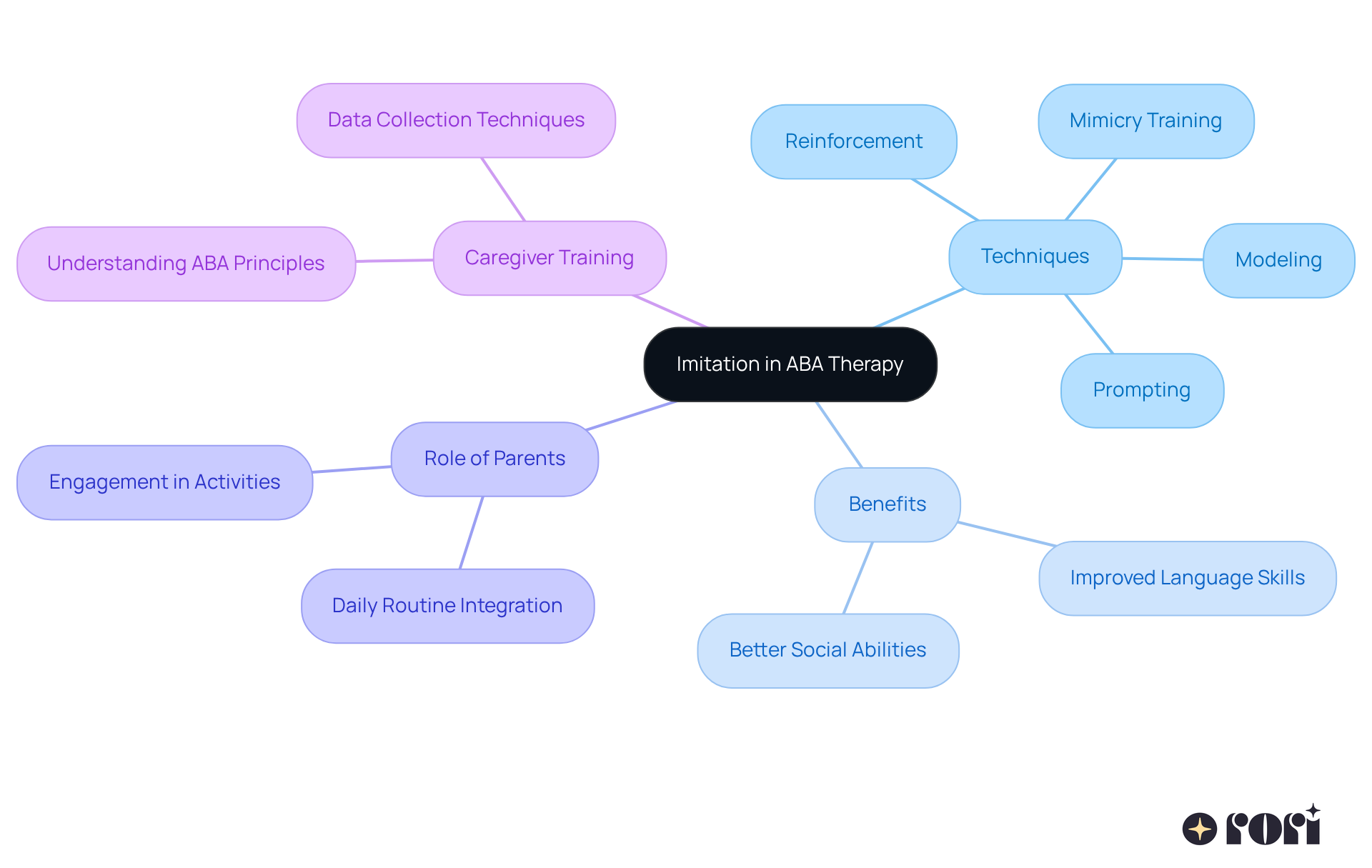
Imitation plays a vital role in developing verbal skills, which are essential for effective communication. One engaging method is echoic training, where kids are encouraged to repeat words or phrases. This approach has shown impressive results in enhancing verbal abilities! For example, studies reveal that echoic conversational response training can boost appropriate verbal responses significantly, with improvements jumping from around 20% to over 81% after intervention. By modeling language and encouraging imitation, clinicians can truly help young learners expand their vocabulary and enhance their expressive language skills.
Successful stories in ABA therapy highlight the power of echoic training as demonstrated by imitation ABA examples. In one inspiring study, individuals with Autism Spectrum Disorder (ASD) who participated in echoic training experienced remarkable improvements in their conversational skills. Participants learned to produce an average of 135 new vocabulary words after the training! Plus, this training not only improved prompt verbal reactions but also helped them generalize these skills to everyday conversations, suggesting a lasting impact on their communication abilities.
The benefits of echoic training are further backed by statistics showing that early echoic behaviors can predict reductions in ASD symptoms. Kids who developed strong echoic skills often saw significant improvements in their overall communication abilities. This really underscores the importance of integrating imitation ABA examples into early intervention strategies for individuals with autism.
Moreover, the involvement of qualified behavior analysts is crucial in crafting individualized plans. These plans include measurable objectives and evidence-based strategies tailored to each child’s unique needs, ensuring that interventions are both adaptive and effective. Continuous assessment and adjustments to these plans are essential to keep pace with the individual’s progress. Caregiver training is also vital in this journey, equipping families with the knowledge and skills they need to support their child’s development at home, leading to better behavioral outcomes and stronger family dynamics. Let’s explore this together!
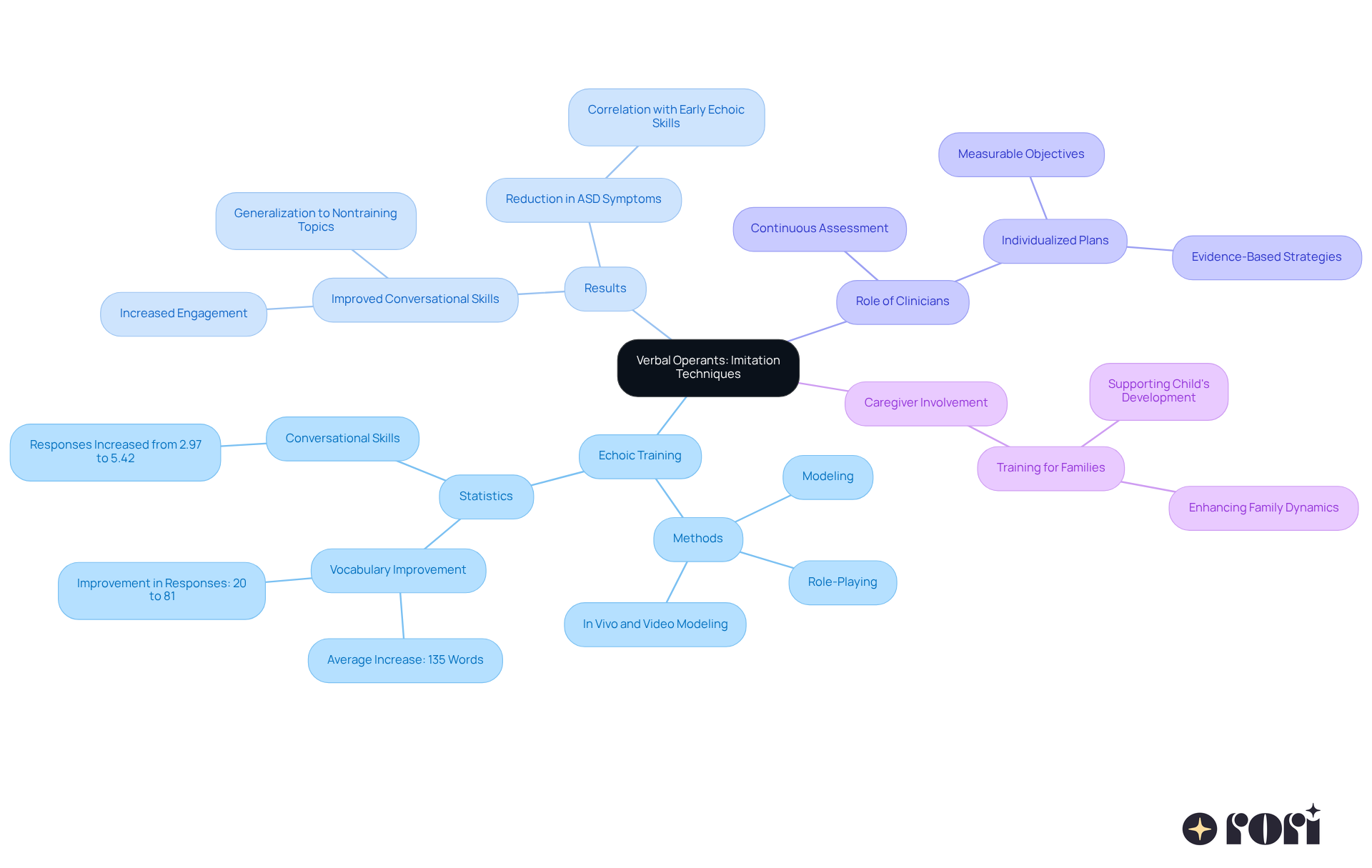
Differential reinforcement is all about rewarding the behaviors we want to see while gently steering away from the undesired ones. Think of it as a way to encourage our young ones to practice imitation ABA examples of positive actions, such as engaging in friendly social interactions or following simple guidelines. By consistently reinforcing these behaviors, we can create a nurturing learning environment that promotes skill development.
This approach is particularly beneficial for children with Autism Spectrum Disorders, ADHD, and learning disabilities. It aligns beautifully with the principles of Applied Behavior Analysis (ABA) therapy, which incorporates imitation ABA examples to tailor strategies that meet each child's unique needs. Did you know that when suggested hours are followed through with active caregiver involvement, about 90% of young individuals show remarkable progress? That's a significant number!
And here's where it gets even more exciting—integrating AI technology to track progress and generate reports can really boost the efficiency of therapy sessions. This means more focused time for treatment! Active participation from caregivers is key; when they are equipped with ABA strategies and data collection techniques, they can make a real difference in their child's behavioral goals and overall development.
Moreover, having qualified behavior analysts on board to craft personalized plans ensures that each child's treatment is specifically designed to tackle their challenges. This thoughtful approach leads to improvements in learning, verbal skills, and social interactions. So, let’s explore this together and see how we can support our kids every step of the way!
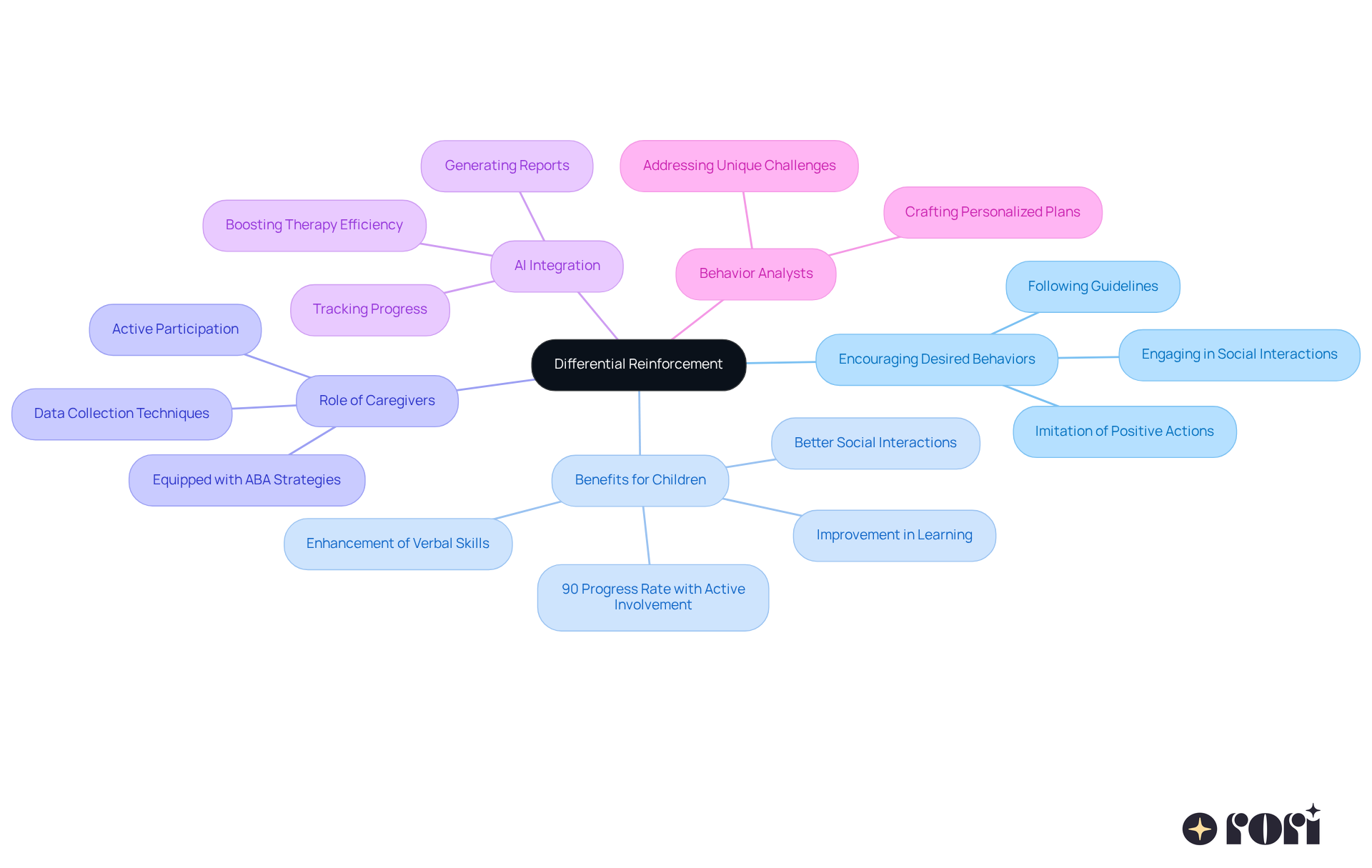
Incorporating AI technology into Applied Behavior Analysis (ABA) therapy creates personalized learning experiences tailored to each individual's unique needs. Imagine being able to assess a young person's development and flexibly adjust tasks to keep them both engaging and achievable! This customized approach not only boosts engagement but also significantly enhances the effectiveness of imitation ABA examples as a learning tool.
At Rori Care, our program development service focuses on personalized planning. Each behavioral plan is custom-designed to fit the distinct strengths and challenges of the youth, establishing clear, measurable objectives for behavior modification and personal growth. Plus, ongoing evaluation and modification are key to our approach, allowing us to continuously monitor and adjust strategies to optimize outcomes.
Research shows that AI-driven interventions can lead to better social communication skills, highlighting how technology can transform educational methods for youth with autism. Successful imitation ABA examples of technology-enhanced learning demonstrate how AI can provide real-time feedback, fostering a more interactive and responsive learning environment.
Moreover, Rori Care combines tailored therapy with advanced AI to automate progress report creation, freeing up more time for treatment. As a result, young individuals feel more inspired to engage, leading to improved retention of skills and overall growth. Let’s explore this together and see how we can support your child's journey!

Motor replication plays a vital role in youth development, helping our little ones mimic physical movements to boost their fine and gross motor skills. Think about it: when kids dance, play with toys, or join in sports, they’re not just imitating; they’re also building social connections and confidence. 🌟 Research shows that play-based activities can significantly enhance physical abilities in children with autism, creating a lively learning environment that encourages movement and coordination. For instance, organized play that involves jumping, clapping, or imitating animal movements can really help improve kids' physical skills.
And let’s not forget the fun factor! Adding enjoyable elements like obstacle courses or music can motivate kids to join in and refine their motor skills even more. By focusing on imitation aba examples, we can equip our children with essential physical skills while making learning enjoyable. So, how can you bring these activities home? Parents can easily set up simple obstacle courses or use catchy songs that inspire movement, turning the learning experience into a delightful adventure. Let’s explore this together and make playtime a fantastic opportunity for growth!
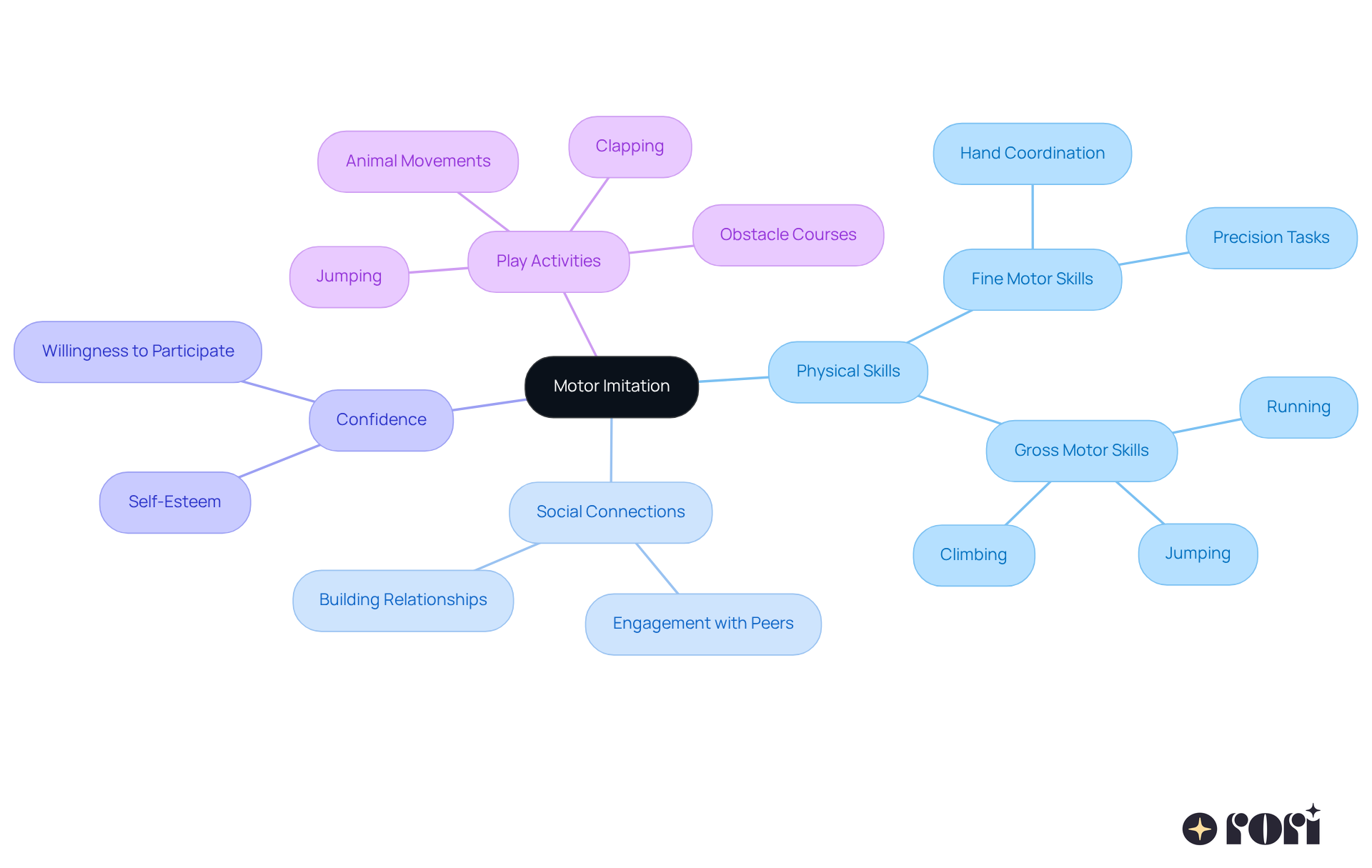
Parents can really boost their children's education by weaving in mimicry during daily tasks. Simple yet effective strategies, like modeling behaviors during playtime or everyday routines, can significantly enhance a young person's ability to learn through imitation ABA examples. For instance, encouraging kids to mimic actions while cooking, cleaning, or chatting not only reinforces skills learned in therapy but also fosters a nurturing learning environment.
Studies show that kids with engaged parents tend to progress faster in therapy, especially in communication and social skills. Methods such as role-playing and guided practice can further enhance the imitation ABA examples, allowing kids to practice skills in real-life situations. By getting involved in their children's learning journey, parents can create a warm atmosphere that supports emotional well-being and strengthens the parent-child bond, making the learning experience both enjoyable and impactful. Let’s explore this together!
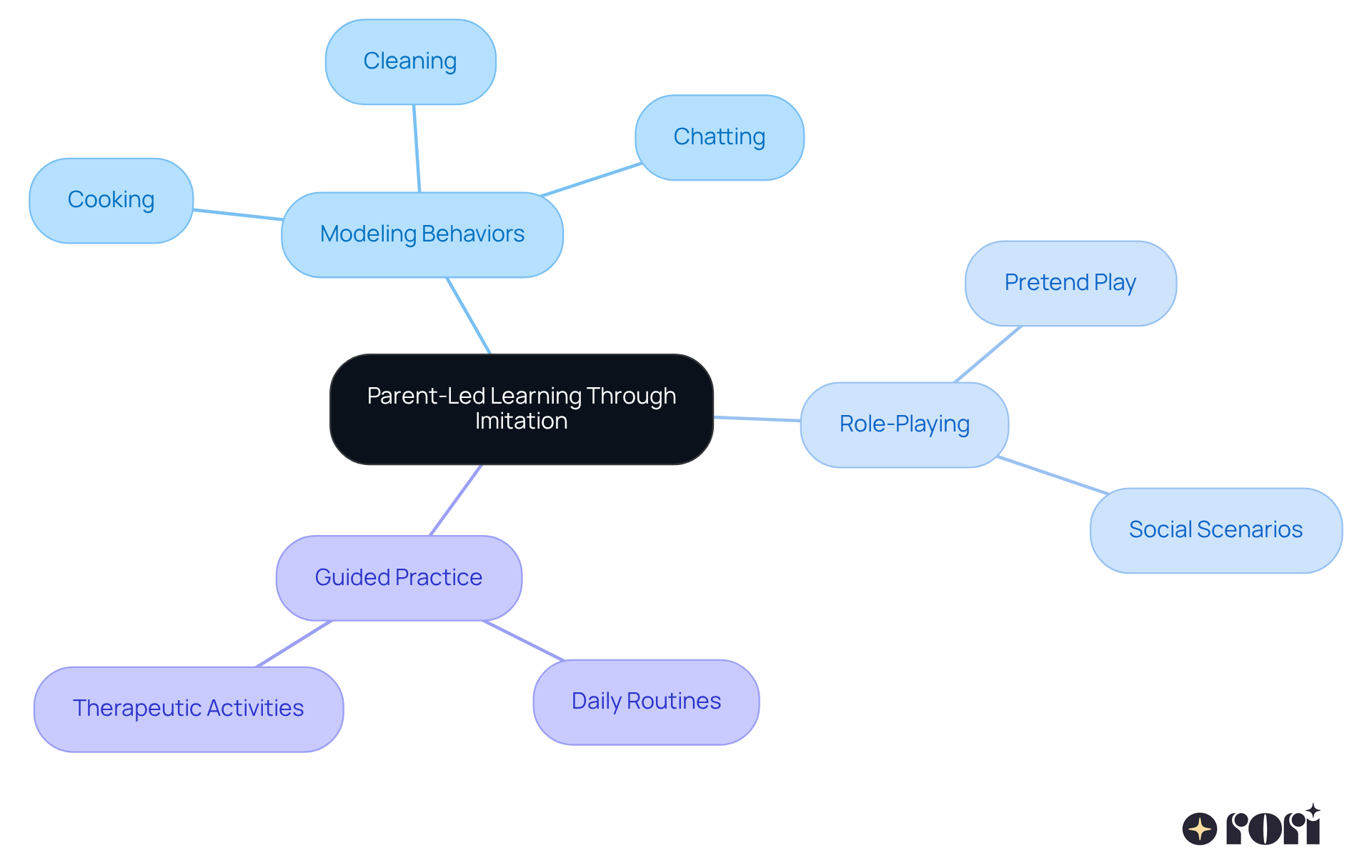
Mimicry plays an essential role in helping kids develop their interpersonal skills. It allows them to observe and imitate appropriate behaviors during their interactions. Organized playdates and group activities, especially those led by qualified therapists, are fantastic ways to encourage children to emulate their peers in fun, interactive settings. By showcasing basic behaviors like greetings, sharing, and taking turns, these activities create opportunities for kids to practice and refine their social abilities.
Group therapy for interpersonal skills can really enhance how individuals communicate and connect within a group. This nurturing environment fosters better competence and relationships. Studies show that organized playdates not only help kids learn important social behaviors but also promote positive developmental outcomes, like improved peer acceptance and communication skills. When young people engage in group activities, they get to experience interpersonal dynamics firsthand, which strengthens their ability to navigate social interactions effectively.
Recent research has shown that focused imitation strategies during these playdates can significantly boost kids' imitative abilities, making them more adept at building relationships and engaging with others. Plus, the development of joint attention during these interactions is crucial, as it serves as a foundational skill for effective communication.
Our focus on early intensive behavioral intervention (EIBI) is particularly important for children with autism, as it can greatly enhance their learning, verbal, and social skills. Overall, promoting interpersonal skills in young individuals can be wonderfully achieved through organized playdates and group therapy that include imitation aba examples. Let’s explore this together and see how we can support your child on this journey!

Multiple case studies highlight the effectiveness of imitation ABA examples in ABA therapy, especially through the dedicated efforts of Rori Care's clinical leadership team. They truly believe in neurodiversity and the success of young individuals. For example, one student who initially struggled to start conversations made impressive strides after learning to use imitation ABA examples during group activities. This led to improved social interactions! Another child learned to follow multi-step instructions by using imitation ABA examples from a clinician's actions during organized play, illustrating how powerful mimicry can be for learning.
Qualified behavior analysts play a vital role in crafting these personalized plans, ensuring each child’s unique needs are met. Data reveals that robot-assisted interventions have led to an average improvement of 17.14% in mimicry abilities among children with autism, compared to a modest 2.86% increase in traditional therapy settings. These real-world applications highlight the transformative power of imitation ABA examples in enhancing communication and learning outcomes for children with autism. This aligns perfectly with Rori Care's commitment to personalized planning, measurable objectives, and evidence-based strategies. As one study author noted, 'Enhancing mimicry abilities during the early phases of development is crucial for enhancing communication.'
Let’s explore this together! The journey of learning through mimicry is not just about improvement; it’s about connection and growth. We’re here to help you every step of the way!
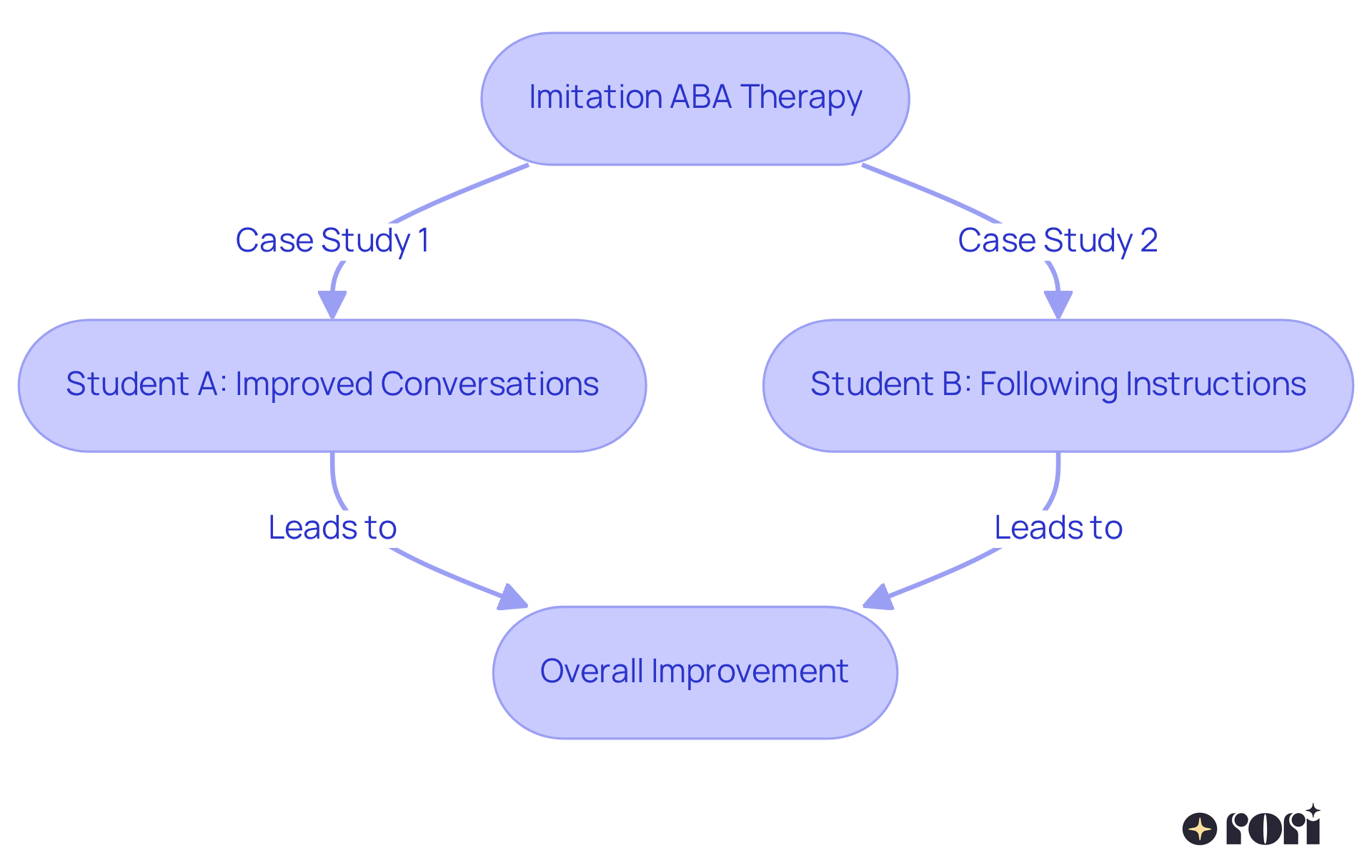
Applying imitation aba examples can be a bit tricky, especially when little ones feel hesitant or struggle to grasp tasks. To really engage these children, clinicians should kick things off with activities that are not only motivating but also align with the young individual’s interests. Think about action songs, mirror play, or follow-the-leader games—these can create a fun and inviting atmosphere that encourages participation! As they become more comfortable, gradually increasing the difficulty of activities while providing clear and consistent cues can help boost their confidence in mimicking abilities.
Regularly checking in on progress is super important; it allows clinicians to adjust strategies based on how each child responds. Research shows that positive reinforcement can really boost motivation, so it’s essential to celebrate those little victories during imitation aba examples. Plus, incorporating play-based activities creates a stimulating environment that promotes joint attention, which is key for effective learning. Everyday activities, like brushing teeth or washing hands, offer practical opportunities for kids to observe and mimic functional behaviors.
Qualified behavior analysts play a vital role in crafting personalized plans that cater to each child’s unique needs, ensuring ongoing assessment and strategy adjustments. Equipping caregivers with ABA principles and strategies also enhances their ability to support their children’s behavioral goals through active participation and data gathering. By embracing these approaches, practitioners can effectively overcome challenges in ABA therapy, leading to improved communication and interpersonal skills for youth with autism. As Dr. Mary Barbera wisely points out, "Imitation is a fundamental ability in early childhood development, essential for acquiring language and interpersonal skills." Let’s explore this together!
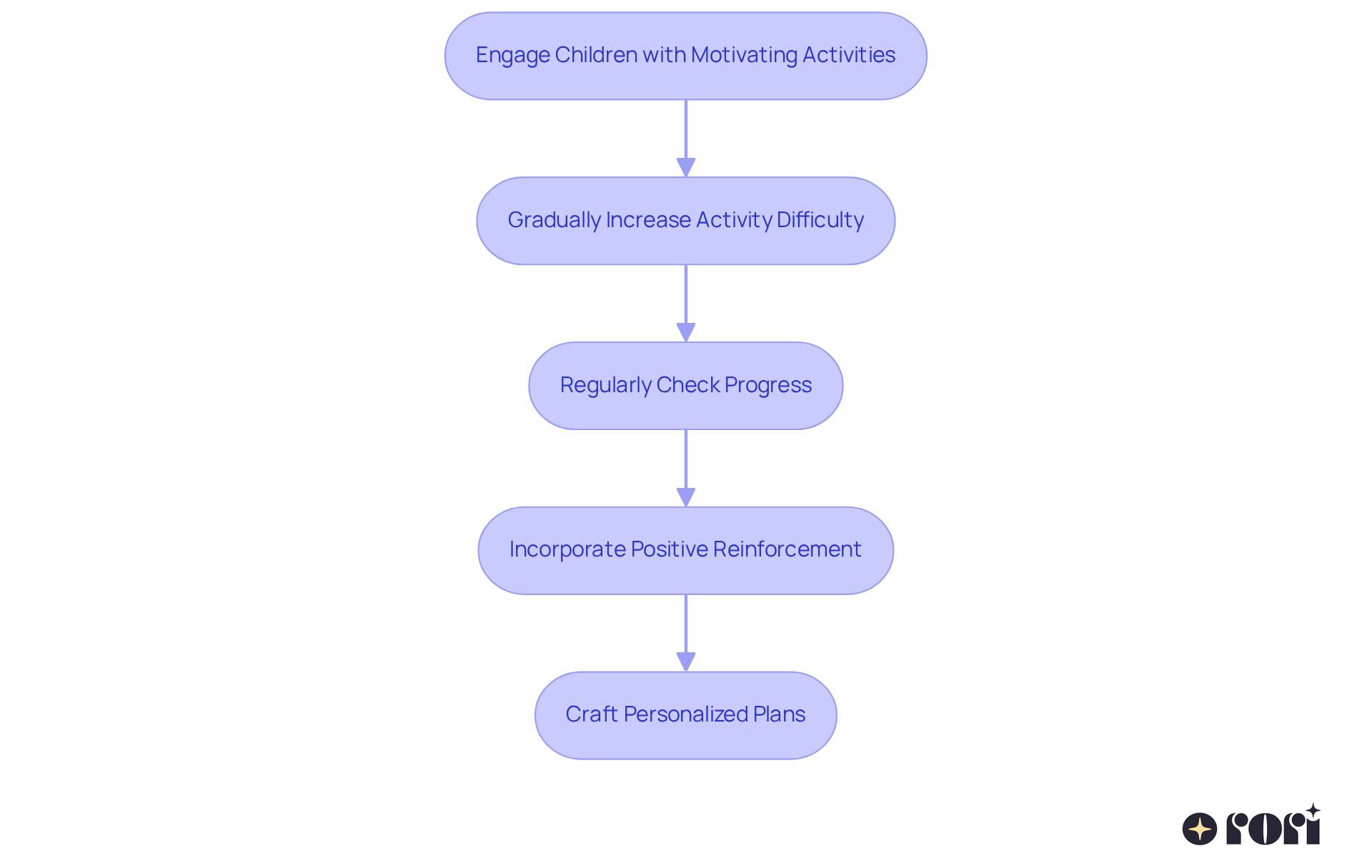
Imitation ABA examples serve as a powerful tool in ABA therapy! It really helps make the therapy more effective and engaging for kids. When young ones are encouraged to watch and mimic actions, it opens the door to developing essential skills like communication, social interaction, and motor abilities. Research shows that teaching kids to use imitation ABA examples is key for those with ASD, helping them connect with peers and succeed in school activities.
Many children with autism struggle with imitation skills, as seen in imitation ABA examples, which can hinder their language development and playtime experiences. But don’t worry—structured teaching methods like Discrete Trial Training (DTT) and fun reciprocal mimicry games, which include imitation ABA examples, have shown great success in building these skills! Plus, imitation benefits not just the kids but also strengthens family bonds, creating a loving environment that supports meaningful growth.
Educating caregivers is crucial in this journey. It equips them with ABA principles and strategies, enhancing their ability to help their children meet their behavioral goals. As children learn through imitation ABA examples, they also enhance their communication and social skills, resulting in richer interactions and improved relationships with others. This really highlights how important imitation ABA examples are for achieving positive therapy outcomes. Ultimately, it paves the way for more independence and social integration. Let’s explore this together!
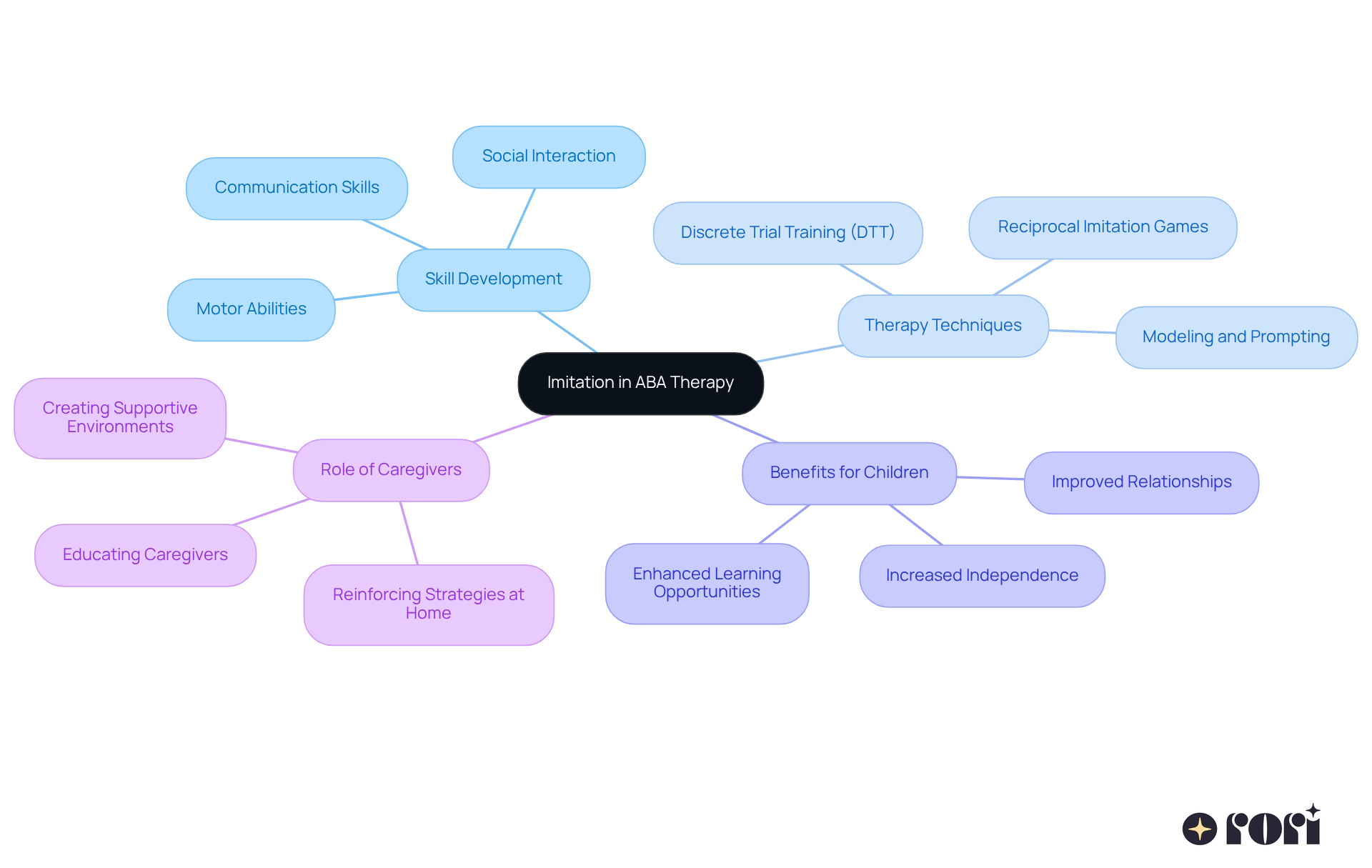
Imitation is such a key part of helping our children learn, especially when we think about Applied Behavior Analysis (ABA) therapy. By weaving imitation into therapy sessions, kids can pick up essential skills that really boost their communication, social interactions, and independence. This approach creates a nurturing environment where children feel empowered to connect with their peers and handle social situations with more confidence.
Throughout this journey, we've explored various techniques and strategies that highlight the importance of imitation in different settings. From verbal operants that enhance communication skills to fun motor imitation activities that build physical abilities, each method illustrates how mimicry can transform the learning experience. Plus, having parents and caregivers actively involved is so important—it can speed up progress and reinforce what kids learn in therapy.
Ultimately, embracing imitation as a learning tool is crucial for fostering meaningful connections and encouraging growth in our children. By putting these strategies into practice—whether through structured activities or everyday moments—parents and caregivers can make a significant difference in their child's development. Remember, the journey of learning through imitation is not just about picking up skills; it’s about building relationships and laying the groundwork for future success. Let’s explore this together and see how we can support our little ones every step of the way!
What is the role of imitation in ABA therapy?
Imitation is a crucial learning tool in Applied Behavior Analysis (ABA) therapy, especially for children facing autism, ADHD, learning disabilities, and other behavioral challenges. It helps children develop essential skills for growth, communication, and social interactions.
How does imitation benefit children's learning and communication?
Children who develop strong imitation skills tend to learn language faster and improve their social abilities. Techniques such as modeling, prompting, and reinforcement are used to enhance these skills in a supportive environment.
What techniques are used to promote imitation in children?
Techniques include modeling, prompting, reinforcement, and both contingent and reciprocal mimicry training. These methods encourage children to observe and imitate actions, enhancing their learning and social connections.
How can parents support their child's imitation skills?
Parents can incorporate simple imitation activities into daily routines, such as playing games that encourage copying actions or sounds, to help their children practice and build confidence in their mimicking abilities.
What is echoic training and how does it enhance verbal skills?
Echoic training involves encouraging children to repeat words or phrases, which has shown significant results in improving verbal abilities. It helps expand vocabulary and enhances expressive language skills.
What are the outcomes of echoic training for children with ASD?
Studies indicate that children with Autism Spectrum Disorder (ASD) who undergo echoic training can learn an average of 135 new vocabulary words and improve their conversational skills, leading to better overall communication abilities.
How does differential reinforcement work in ABA therapy?
Differential reinforcement involves rewarding desired behaviors while discouraging undesired ones. This approach encourages children to practice positive imitation behaviors, fostering skill development in a nurturing environment.
What role do caregivers play in the success of ABA therapy?
Caregivers are vital as they actively participate in the therapy process, applying ABA strategies and data collection techniques to support their child's behavioral goals and overall development.
How can technology enhance ABA therapy sessions?
Integrating AI technology can help track progress and generate reports, making therapy sessions more efficient and allowing more focused time for treatment.
Why is individualized planning important in ABA therapy?
Individualized plans crafted by qualified behavior analysts ensure that interventions are tailored to each child's unique needs, leading to effective treatment and measurable progress in learning and social interactions.